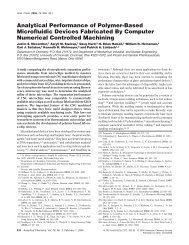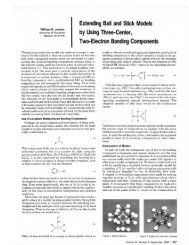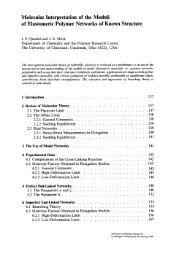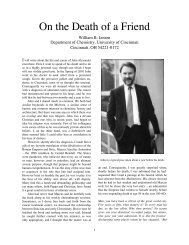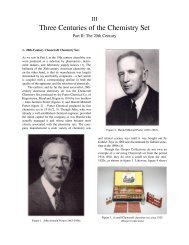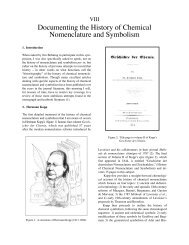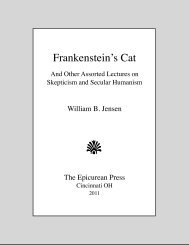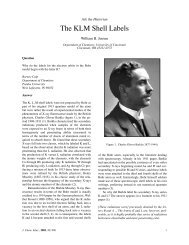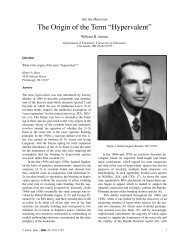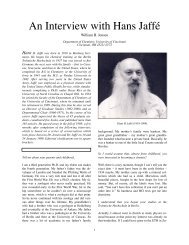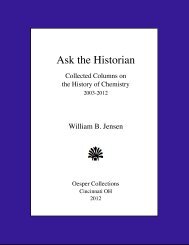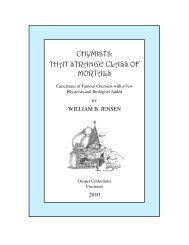The Leyden and Stockholm Papyri - University of Cincinnati
The Leyden and Stockholm Papyri - University of Cincinnati
The Leyden and Stockholm Papyri - University of Cincinnati
You also want an ePaper? Increase the reach of your titles
YUMPU automatically turns print PDFs into web optimized ePapers that Google loves.
THE LEYDEN & STOCKHOLM PAPYRI<br />
the document, based on Reuvens’ earlier summary <strong>of</strong> its contents,<br />
in the first volume <strong>of</strong> his Beiträge zur Geschichte der Chemie,<br />
though he rather surprisingly made no reference to it in his later<br />
1886 monograph Alchemie in älterer und neuerer Zeit (3).<br />
! In 1885 the French chemist <strong>and</strong> chemical historian, Pierre<br />
Marcellin Berthelot, made use <strong>of</strong> the <strong>Leyden</strong> papyrus in his speculative<br />
account <strong>of</strong> the origins <strong>of</strong> Greco-Egyptian alchemy (4). Like<br />
Kopp, his knowledge <strong>of</strong> this work was based largely on Reuvens’<br />
earlier summary, though that same year Conradus Leemans,<br />
Reuvens’ successor as the Director <strong>of</strong> the <strong>Leyden</strong> Museum,<br />
finally published the complete text <strong>of</strong> the original papyrus in Latin<br />
translation (5). Since this appeared as part <strong>of</strong> a two-volume collection<br />
<strong>of</strong> translations <strong>of</strong> other papyri, Leemans gave each <strong>of</strong> them<br />
a distinguishing letter, whence the name “<strong>Leyden</strong> papyrus X.”<br />
Two years later Berthelot published a French translation <strong>of</strong><br />
Leemans’ text along with a detailed chemical commentary (6),<br />
<strong>and</strong> in 1906 he also published a reproduction <strong>of</strong> the original Greek<br />
text as well (7).<br />
! Meanwhile, the papyri given to the Swedish Royal Academy <strong>of</strong><br />
Antiquities languished in its archives until their transfer to the<br />
Victoria Museum at Uppsala in 1906, when they came to the attention<br />
<strong>of</strong> Otto Lagercrantz, who discovered that they also contained a<br />
collection <strong>of</strong> chemical recipes similar to that <strong>of</strong> the <strong>Leyden</strong> papyrus,<br />
<strong>and</strong> who finally published the original text with a German translation<br />
in 1913 (8). That same year the Austrian chemist <strong>and</strong> chemical<br />
historian, Edmund von Lippmann, published a detailed article<br />
describing <strong>and</strong> comparing both papyri, which eventually served as<br />
the basis <strong>of</strong> his account <strong>of</strong> these documents in his epic 1919 work<br />
Entstehung und Ausbreitung der Alchemie (1, 9).<br />
! It was not until 1924, however, <strong>and</strong> the appearance <strong>of</strong> John<br />
Maxson Stillman’s Story <strong>of</strong> Early Chemistry that an Englishlanguage<br />
account <strong>of</strong> these papyri was finally published (10).<br />
Indeed, Stillman’s book was, <strong>and</strong> still remains, the single best<br />
English-language summary <strong>of</strong> the work <strong>of</strong> such classic chemical<br />
historians as Kopp, Berthelot <strong>and</strong> von Lippmann, none <strong>of</strong> whose<br />
original books were ever translated. Though Stillman also gave a<br />
partial translation <strong>of</strong> several <strong>of</strong> the recipes from both papyri, it was<br />
not until 1926 <strong>and</strong> 1927 that Earle Caley finally provided a set <strong>of</strong><br />
- 2 -



